Month: January 2022
Complaining in Process: Sketches



“Sometimes you have to shout because you are not heard. If you have to shout because you are not heard, you are heard as shouting. If you are heard as shouting, you are not heard” (Ahmed, 2021, p.89)
I remember it was the last year of my undergrad. We had to find a thesis advisor, I had no idea who to choose. One of my best friends started working with one of the professors, one of the most renowned, he was famous and sold very well.
I remember sitting on River Boulevard one night. She was telling us how her meetings with the professor were going. She told us something that seemed strange but that night she gave us no more clues that something really odd was going on.
One day, we were both in the exhibit hall at the university. I was helping her set up the lights for the opening of her thesis. Somewhere between thin tears she turned to me and said:
-I am planning to file a complaint. Something serious has happened with xxxxxx -.
I went into shock. To think that months before I wanted to be in her position.
-I wanted to work with him because I admired him- I thought.
We gave each other a hug as if holding each other, comforting each other. It was not the first time this had happened to her and I had also been a victim of another man and his masculine arrogance. We knew that surely, this was not going to be the last time either.
To this day I think about this situation with fear, with rage. I am not even able to use his real name. I’m afraid that his academic, work and even spiritual connections will grab me with one of his tentacles and pull me under, just for talking-just for thinking about it. But when I write it here, for a moment it feels like I can escape him (all of them) and his power.
T H E C H A I R
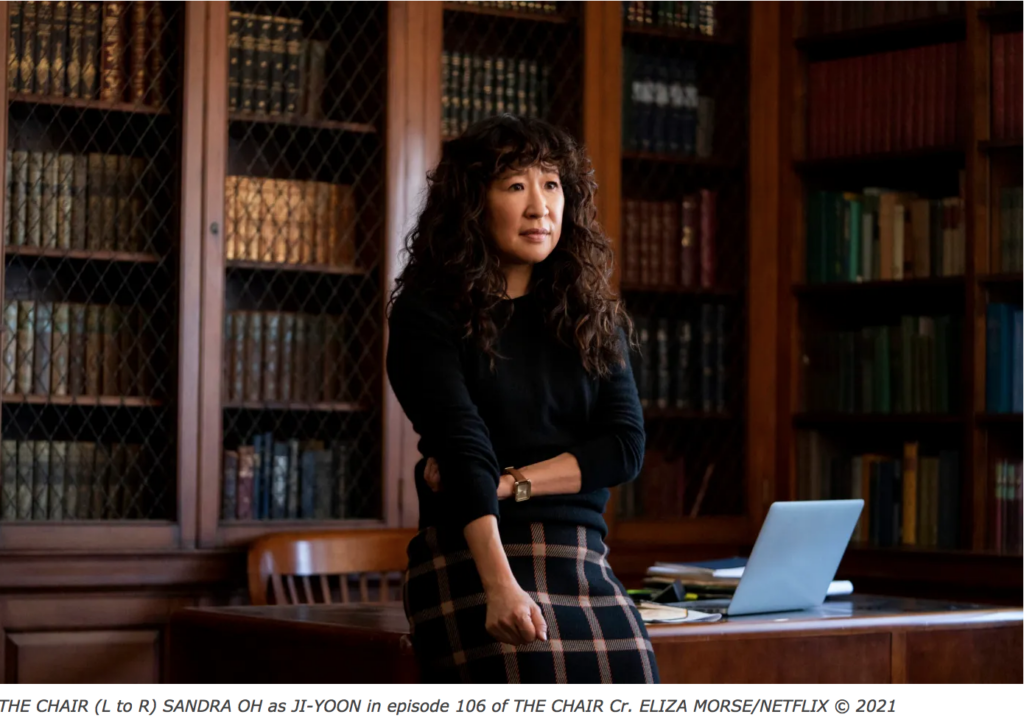
With your permission, and I hope I’m not in such bad taste, I bring here a series from netflix, which is directly related to our topic.
It is a current reference of popular culture. Problematic like any television event, due to the spectacle, dramatization and sometimes light way of dealing with complex issues. And also under the suspicion and mistrust generated by a platform like Netflix telling contemporary history.
Beyond the care and distance that will have to be exercised in the face of the trendy phenomenon of historicization of the last 30 years, as well as the gentrified contemporary portrait of the globalized society in which we live; I find it interesting not to ignore the new audio-visual novels that millions of people consume. And at least recognize some accurate issues that I find in this series.
Created by American writer Amanda Peet and Harvard PhD Annie Julia Wyman, the show stars Sandra Oh as Dr. Ji-Yoon Kim, the first woman chair of the English Department at a stuffy ambient.
Short and not exhaustive, it captures at least, not perfectly, entrenched structures, such as sexism and racism in the world of universities; and how “seemingly open” institutions still struggle with including marginalized groups and diverse candidates in their jobs.
I think it is not bad to take a look at it if we are reading this book. And thus be able to discuss the relevance of its existence, and if it adds to or subtracts from the theme, dramatizing it and including a perhaps cheesy love story. Not without saying that perhaps it is also conservative in its critique of power.
I close this brief review, highlighting the humor of the series, without forgetting and thanking that this factor is always oxygenating.
The invitation to discuss is open.
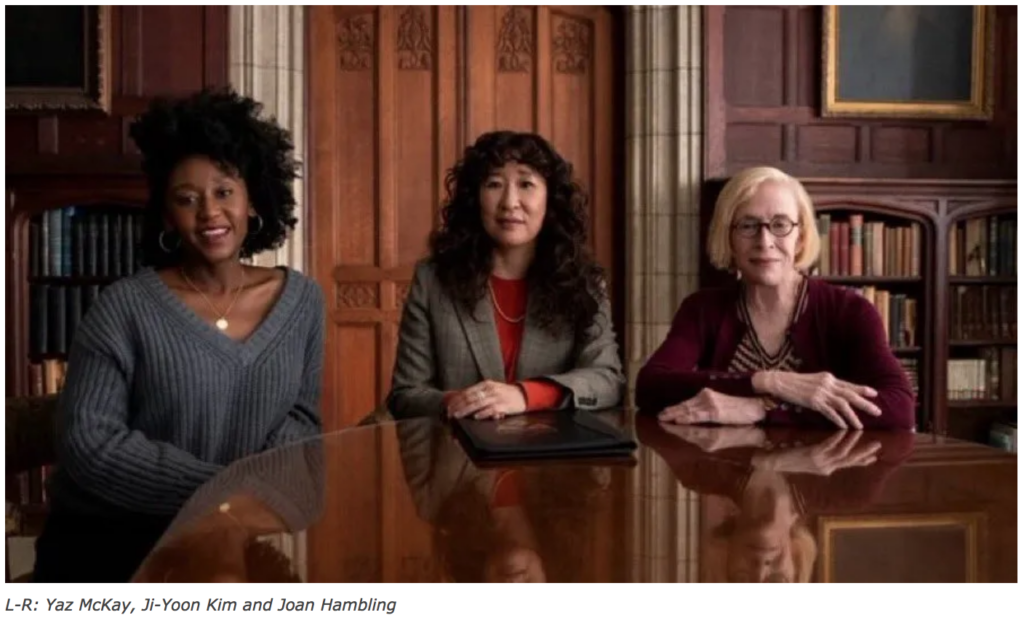
Here is one of the most interesting reviews I found online, by cultural writer Alessa Dominguez.
https://www.buzzfeednews.com/article/alessadominguez/netflix-the-chair-review-sandra-oh
Voice amplifiers
Looking up for artists that work with communicative bodies, I reminded chilean artist Francisca Benitez. In her work she amplifies the voice of deaf people through a series of performances in which she uses ASL (American Sign Language), involving the community, in public space and in museum context. These series of works function as a call of attention on how discriminative oral language can be to people that lack the hearing sense.
My aunt, the sister of my dad is deaf. She lost her hearing capacity due to meningitis disease when she was six months old. In the time when I was a kid, she frequently came to our house on Sundays for family gathering. I remember how she read the lips. For that reason, we needed to talk with her really pronouncedly and slowly so she could understand what it was said, although I could sense in collective conversations how she got lost. She could also feel vibrations. During one summer we went with her to the beach house. She slept in the room next to my brother, so we should walk quietly at night not to wake her up. “She can feel your steps in the wood” thats’s what my mother said. I don’t see her so often anymore. Fortunately with internet and chat interfaces she is connected and participates actively in social media. We have encountered lately in that virtual sphere.
As I have researched, laws for deaf people in Chile and globally have improved to more integration in different levels. In the last decades, sign language has been recognized in the laws of different countries.
By the time I was a kid and an adolescent, and until some years ago, I was not completely aware of the difficulties that a person with disabilities need to face in daily life. Therefore I ask myself about “normativities” of the language. What I didn’t know for example, and realized after reading Benitez artistic research is that facial expression, unlike in oral communication, is part of the grammar: it is not an exaggeration, it is part of the word. It is not enough to make the sign of “happy,” you have to appear happy to make that sign. This is extremely interesting as the body integrally needs to perform the emotion.
Benitez learns the ASL language of signs in the middle of her artistic career and delivers it, through actions involving herself and other participants, in single or collective actions.
Through her own biographic experience, her father a non hearing person, she realizes the importance of learning other ways to communicate. She didn’t urge to learn it before, as her father was adapting to the situations, more than the context adapting to him.
What I find more interesting and relevant in her practice is how she experience this act as a way of decolonization of the language, of questioning the system of domination in which we live in. And also how society omits disabilities in order to perform unilateral forms of communication. She uses the artistic context as an area of intersection, where people come with a curious attitude. In this environment she triggers in the audience different communication possibilities, through the body, and beyond orality.
Francisca Benitez percibes her work as disruptions, not pretending to give solutions, yet to bring a question to the viewers. I think about solidarity and empathy within this work. And how the artistic practice can be not only an aesthetic tool but also an agency to society integration, by extending language in a post-colonialist perspective.

Francisca Benitez “Son en señas” (2015) Performance. Centro de Arte Contemporaneo Wilfredo Lam, Cuba.
www.franciscabenitez.org
(Un)numbed body
In the left part of my belly it burns
Whenever my speech I’ve decided tu numb
In Freud words it would be called repression
So that’s why my body reacts to it in compression
It sounds, it twists
And therefore I wonder
Which of my experiences I’ve determined to carry
as a silent burden?
Is it fear to think about it and letting it out?
Cause it could upset the status quo
If i reclaim and speak and shout
Public sphere discourages making waves
So it take brave to speak out
reclaim and complain
For the sake of my guts
I have resolved to tell
Despite fright or the warning to fail
I prefer my discomfort exhale
I amplify the voice of my thoughts
Therefore my reasons I talk
Speaking out-loud when something is wrong
Decompressing my pain which no longer prolongs

Communicating bodies. Image from artist Francisca Benitez (Chile) “Soliloquy in Signs” (2014)
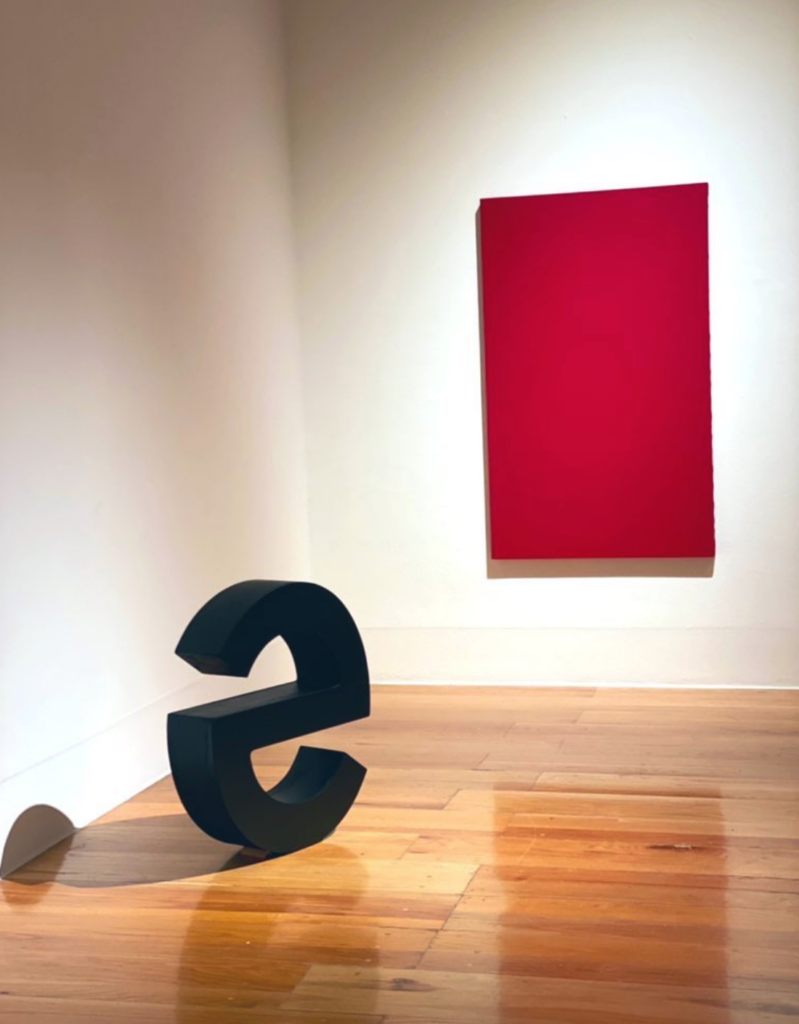
As many of you know in Spanish, unlike English, adjectives, verbs and nouns have gender. Feminine words generally end with the letter “a” and masculine words with “o”.
Faced with this, in the last decade many alternatives have been proposed to replace these vowels and build a more inclusive language. Different proposals from Latin American countries or Spain suggest the “e”, the @, or the “x” as a symbol to replace and neutralize the way in which we express ourselves, without necessarily having the connotation of gender, which is so often unnecessary.
Last year, the Mexican artist Mario García Torres proposed in his last exhibition a proposal that has generated much controversy. He and typographer Aldo Arillo created a new vowel for Spanish as an attempt to solve the dilemma of gender and inclusion in the language. The vowel was created in his “Secte” project, which is part of his exhibition “The Poetics of Return”, the retrospective of García Torres in Marco. Museum of Contemporary Art in Monterrey.
The vowel’s proposal was shown at the museum, where it was launched. There was a sculpture of the letter, a wall with words that exemplify its use and a video. “It’s a letter to try to solve the gender problem. It’s actually a ligature of three letters: a, e, and o. We did it so that it was just a specific sign and that it was a new letter that doesn’t have gender,” García Torres said in an interview. “It’s called ‘sect’ and the idea is that it becomes the sixth vowel of our vowels.”
The letter is a speculative glyph, the artist explained, and is currently only available in the NeuLeon typeface, created by Arillo. “(Hopefully) other fonts eventually begin to add this symbol. It’s not easy,” said the artist of Monclova and one of the Mexican artists with the most projection abroad. With the character, the artist and typographer propose that it can be used instead of e, @ or x, which have been used informally in inclusive language.
Arillo mentions signs like the # that for a while was used only for numbers and is now indispensable in internet culture. Several feminist movements of the 20th century have demanded an inclusive and non-sexist use of language, since in Spanish, masculine pronouns, adjectives and terms predominate. However, specialists and institutions such as the Royal Academy of the Spanish Language have resisted any type of change
“Somehow you had to have a graphic posture, how to solve this in a good way. Language is not something static, it is a living convention, which changes according to need,” said Arillo. “From a graphic and typographical point of view, this sixth vowel proposes a solution, a proposal, something to open a conversation on the subject.” *
For the creation of the vowel, the experts were based on the theory of typography. Arillo explained: “We wanted this sign to have characteristics such as legibility, harmony and rhythm, something that e, @ and x lack in this type of use.
García Torres and Arillo will present the vowel “secte” at the Association Typographique Internationale (ATypI) online congress soon, and at TypeCon, a symposium to be organized from Philadelphia. It is possible to request the letter for its use in the email aldoarillo@gmail.com.
The MAIN QUESTION HERE is: Why would a white, heterosexual and privileged man have to decide how to represent a vowel that alludes to a fight that clearly does not belong to him?
Different groups and collectives, including several feminist groups, have shown indignation and anger at the artist’s proposal. I understand why. I find it interesting to share this, to open the discussion.
* source: https://www.elnorte.com/aplicacioneslibre/preacceso/articulo/default.aspx?__rval=1&urlredirect=/crean-mexicanos-vocal-inclusiva-para-el-espanol/ar2140611
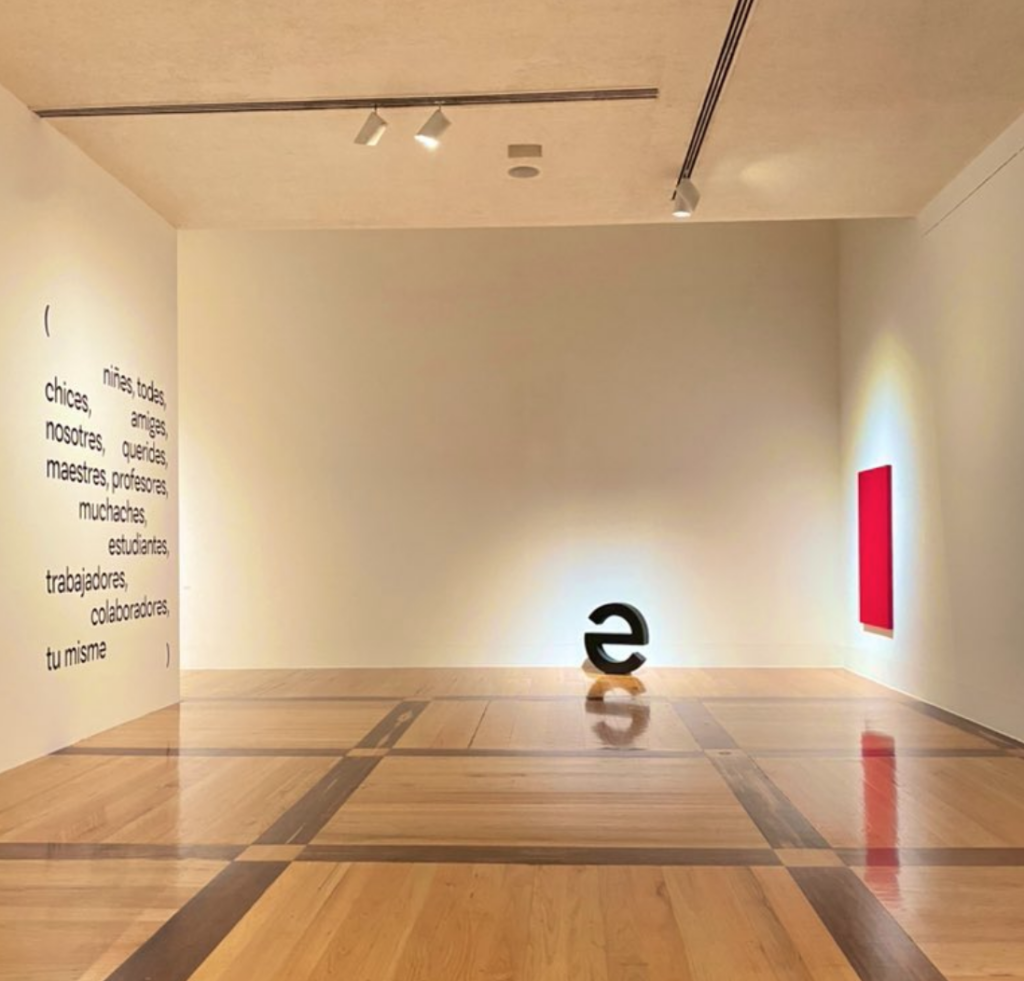
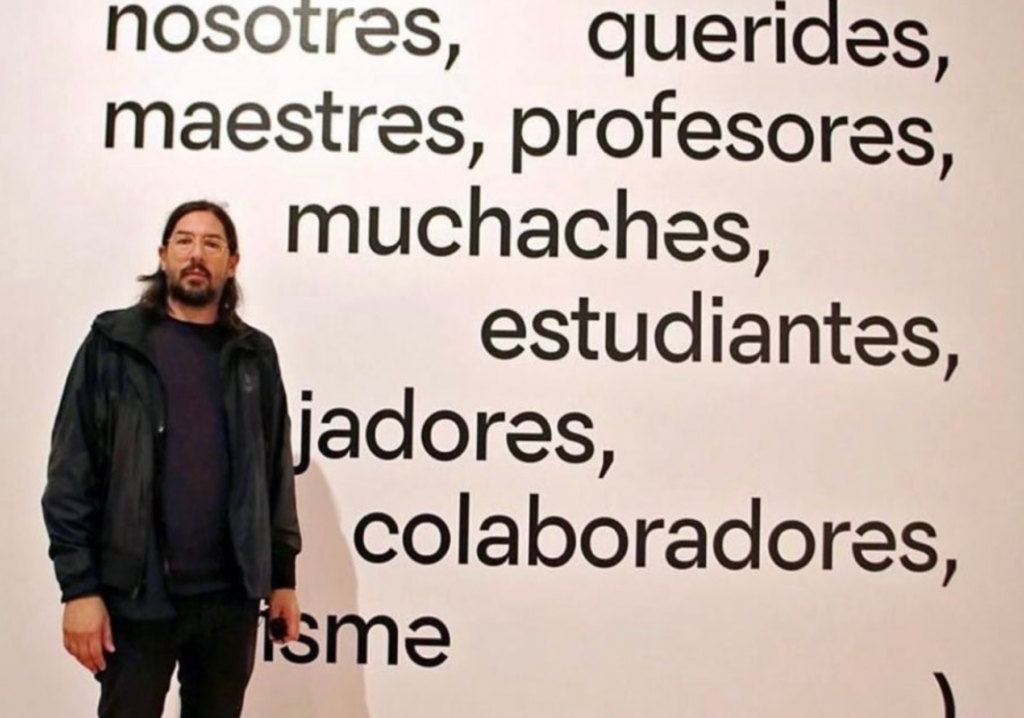
БЕЗНАЂЕ (BEZNADJE)

This fairytale is a well-established concept, an interpretation, and the invention of the main protagonist of the story.
“My poor little Nadja, I wish I could scoop up your remains every time you fall apart,” she said, addressing herself, facing the text her thoughts had just woven.
The story consists of a bunch of words in English, many complaints, self-criticism, world criticism, global politics, conflicts, and personal reflections. Its content is not actually a story at all. It is more of a fake, fictional etymology of the Serbian word “beznadje” which started all this textual fuss.

2017
©Nadja Kracunovic
ONE AND ONLY CHAPTER:
ALL THE LET’S
Neoliberal capitalism breeds charming little monsters. My name is Nadja, welcome to my overexistence.
There is a word in my mother tongue, a word in which I had planted my ego years ago and have watered it ever since. In Serbian, we say beznadje / beznađe meaning hopelessness or more precisely: without hope. This compound combines the word bez (without) with my beautiful name (Nadja), by coincidence. The world without Nadja makes me sad. Sometimes I blame my small, generous family for splashing so much love onto me. You are guilty of my ego plantation and egocentric perspective. You made me overexist. There are times when I miss them so much that being so far away from their warm, loving bodies tears me apart. Time has shown me that they are the creators of the most beautiful and disgusting things that my being consists of. Let’s discuss it in my monologue.
My anxiety is reversed. Instead of, as a hedgehog or a snail, squeezing my face inwards, I go for more of what makes me anxious in the first place. Instead of covering my face with an emergency blanket, I apply for a new open call, I make a new friend, and I make new art. I overwhelm myself, volunteering for my own destruction. I stretch my body on the ceilings of contexts I do not even belong. It hurts so damn much being a captive of your own brain. It makes me feel trapped, stupid, unable to progress. I have been hanging on this clothesline ever since, and it seems I won’t pick up my clothes soon. Let me dry.

2019
©Nadja Kracunovic
I am tired of being excited. Recently I asked my mom if I was born like this. I believe I was: strongly into everything along the way, wanting, eager for everywhere and everyone, not belonging, not existing for real, never loving anybody but their love for me, never accepting anything that does not benefit me in some way… The vicious cycle of every, any, every. The excited monster always wants to see another garden and love another flower. I am a factory. My production is unbelievably fast, so is my consumption. However, I do understand this method of mine very well, I simply fear not having the options. If I get one NO, there is something about to be a YES. If he leaves me, there is another HE loving me in the background. If you make me choose just one, I will disappear from it, whatever it is. I am a union of the contexts and queen of my clothing. I am not one, but plural. Let me be swallowed by my monsters, it is the only way to survive.
I thought about the book title that I might write if I switch from art to popular psychology book title copywriting. “How to plant, cultivate, and water your multiple egos”. Best-seller, right? I would give a course on multitasking, productive puma advice, and self-destruction, inevitably. And what is with me and this puma thing? I do compare myself to a black panther on a daily basis. Let me be the best there is in the capitalist jungle.
Yesterday I cried my face off while jogging through a German landscape. It felt like it was about to explode. I am not sure what exactly, but I felt its shape right above my bladder, growing and pulsing. Like a creature. I gave birth inside my belly. The pregnant puma is starting to feel the pain. It hurts so much. It pierces and paralyzes me. I cannot do this anymore. Stretched over my red sofa, I tried to collect the puzzle pieces and get through the fog I found myself surrounded with. It felt so blurry that I didn’t even know how to carry myself from the sofa over to my bed in the corner. It took my excited body and it suffocated me. How can I live in this world without Nadja? If she becomes tired and sad, what is this all about? She hurts me, she is killing me. I want her to calm down and pick up the fucking clothes.
Puma needs to sleep for the time being. Now, let me breathe and sing Nadja a lullaby.
Gabriela Parra Sánchez
11.01.2022
1. Introduction of “Cat calls of Berlin”:
It has been shown that social media, and mostly an app like instagram, is a wide space with questionable boundaries, in which a lot of bullying and harassment can happen, but also it can be the platform where one can report acts of hate and abuse – towards women and LGBTQ+ people, in the majority of the cases.
In November I was talking to a friend that lives in Berlin about my COMPLAINT!ivism? course, the topics we discuss about, the book we are getting our input from and the learnings I get from reading the blog. I told him about the second task and he sent me this instagram account and said: “give it a look, it might be of your interest.”
I am talking about “Cat calls of Berlin” @catcallsofberlin. Forehand I didn’t know what “catcalling” meant, it sounded like a very tender name to me for such an act.
It is “the act of shouting harassing and often sexually suggestive, threatening, or derisive comments at someone publicly”. (1) But still it was not clear enough to me why is it called catcalling?:
> “It’s called “catcalling” because it’s associated with those verses that are usually made to call cats, and bring them closer”. (2).
According to this the name of the account “Cat calls of Berlin” exposes the sexual threatens and comments that people have received in the streets of Berlin, and as they state it on their instagram biography, it is a Chalk art movement against street harassment.
It is an initiative carried out both digitally and analog on the streets from multiple cities, and its aim is to expose different harassment experiences through comments. People first share their testimonies anonymously through instagram direct messages, then the team writes a piece of the testimony on chalk nearby the place it happened and then post a photo of it, in addition to a screenshot of each testimony.
At first, even though I didn’t understand exactly what every message in every picture meant, I could imagine the heaviness of emotion every post carries. Not only because of the remembrance of that specific situation in which the victims were put into, but also because out of this exercise, victims are able to build empathy and advise others which places they were harassed in. This allow women, and everyone, to know in advance that something like that happened just right there, in that specific street, corner, whatever it was.
2. Deeper analysis of “Cat calls of Berlin” and its impact:
Although this movement was born in NYC, I wanted to focus on the Berlin’s account for some reasons:
Mainly because it is a city I frequent a lot, and even though I recognise I am in a more open and advanced culture towards the one I was born in, one may think that this type of comments or abuses are not that common in here, but through this account we can evidence that it has nothing to do with the place, its the people that provide this scenarios.
Reading these comments has reminded me the times I have been exposed to these types of comments; because of the way I was dressed, because of walking really late by my own, or even because I was talking in Spanish and just because I am latina makes them think I like to be exotized or approached in a vulgar/sensual way.
I haven’t faced such a comment in Berlin until now, but it triggers me that it can happen to me any day and I don’t know what to answer back nor how to react. Language is still a struggle to me and I will be surely shocked.
It was also sad to read many testimonies from really young girls ages 12, 13… To see how vulnerable women are still on the streets but hopefully there will always be someone that empaths with your experience and maybe they’ll make art out of it to encourage others and show they are not alone. Testimonies in the page oscillate from comments like: “Ey Puppe, willst du was machen?” “Hey sweety, do you wanna do something? (Posted on the 20.10.2021)”, to “Den Arsch will ich an mir spüren” “I want to feel that ass on me” (Posted on the 07.06.2019).
On one side, in these cases the victims are attacked by people they might have never seen before or even won’t see anymore. On the other side, the testimonies that appear in Ahmed’s book “Complaint” the victims and aggressors had already stablished- relationships such as: professor-to-student, boss-to-worker and so on. Which, I reiterate, does not make the experiences any more or less valid, nor traumatic, it is just a comparison to show that no matter the level of relation towards another person, if there is no consent, it is abuse.
In addition, by analyzing some aspects of this movement (which I really value and admire), I realized that the messages are written in chalk on the streets and as is know chalk can be easily erased by rubbing on it, or with the rain as it’s exposed to an open environment. It is not a material that permits that the message stays for a long time or even permanently; though the damages and the trauma are already permanent.
The purpose of the movement is to commemorate this situation even if it is not done justice in its totality, since its purpose is more to condemn this type of events and in a certain way to mortalize these acts in the space in which they were carried out, showing support for the victims. It is not their obligation to make this ‘art’ permanent, but I wonder if the reason for is to be written on chalk has to do with a fear against banning or another type of reason that won’t allow this to continue.
Of course to read this on the streets causes uncomfortableness to the eye and the dignity, but it is necessary to spread the word and the fact that it happens. Perhaps not to everybody, perhaps just to the unlucky ones, just to some unlucky cats.
Furthermore, I noted also that not all messages are written explicitly. It may be due to a restriction given from instagram under its terms in order to make the post available for everyone, or even for keeping respect on the streets, as children may read them. Which also concerns me in a way, because abusers do not have any type of respect while
doing this type of comments and they are always very explicit; but when one gets the chance to expose and denounce it, it has to be narrowed for it to be reached. In a sense, the abuser has freedom, while the victim must restrain herself/themselves.
Here I show two examples of what just was mentioned:
Posted on the 19.12.2021
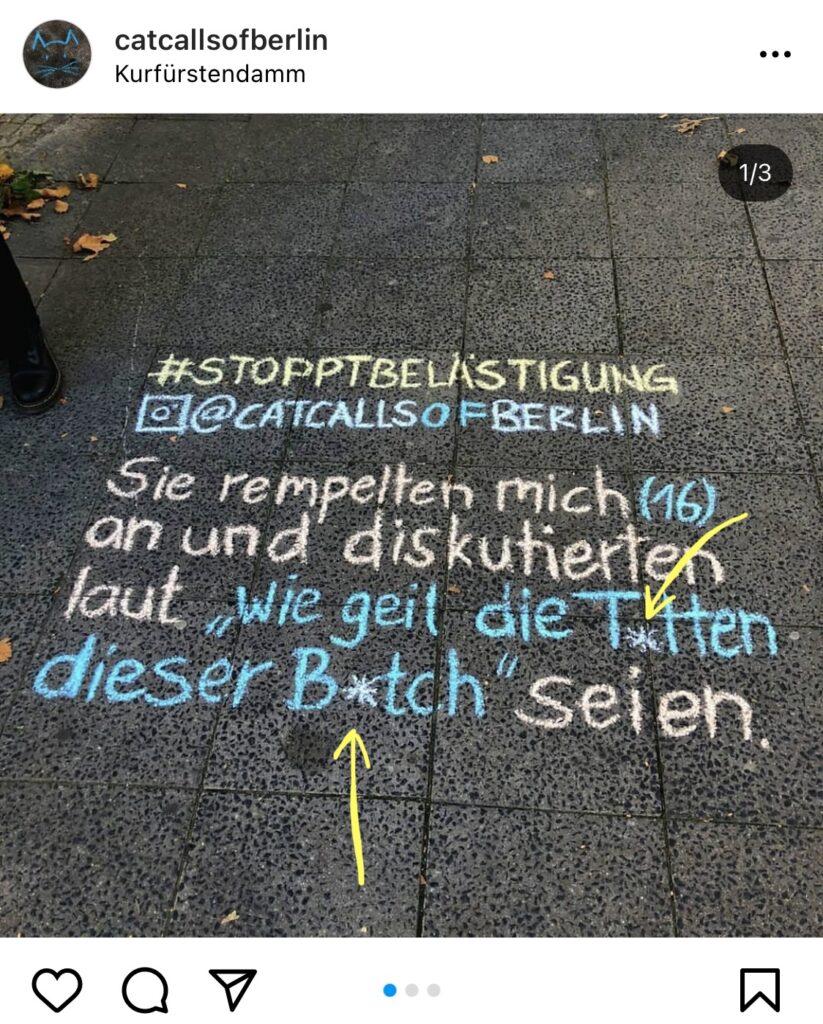
Posted on the 04.01.2022
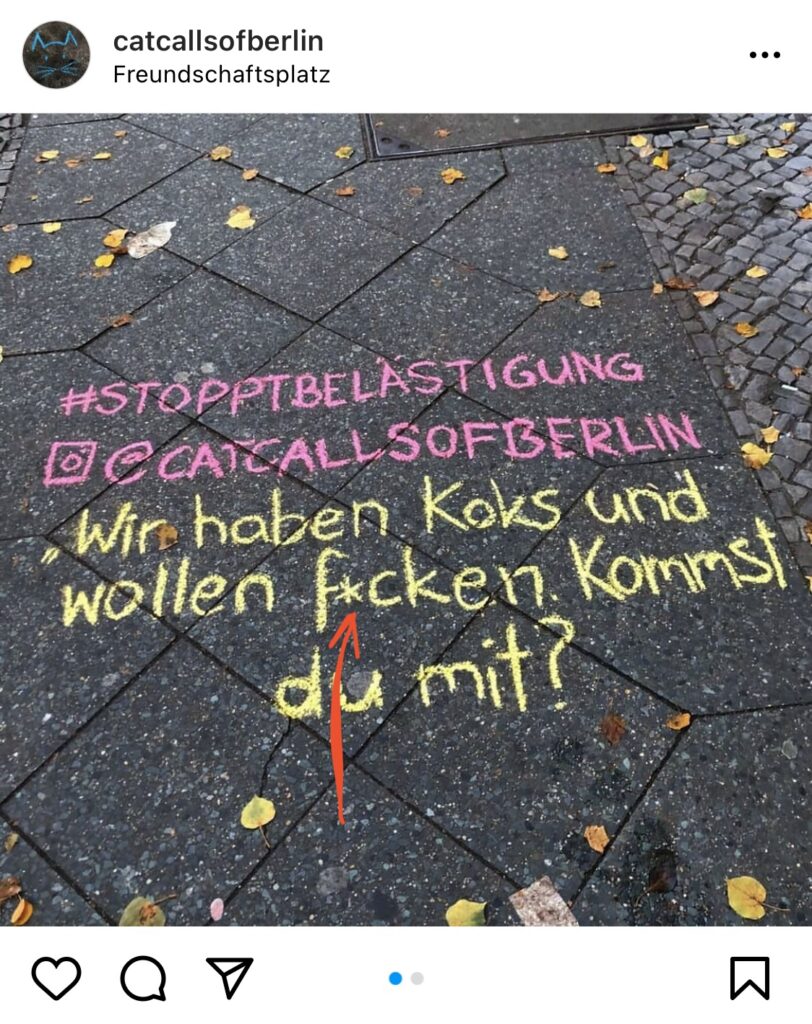
3. Conclusions and perspective after this exercise:
These types of initiatives on social media permit the spreading of warnings towards scenarios of this kind (like the ones we were able to read along the lines of “Complaint” by Sara Ahmed), as it instantly catches the eye of the pedestrians and will leave a temporary mark on the space due to the unfortunate events that happened right there. Still, the experienced harassment from the victims will never be fully portrayed and the abusers are not being loudly called nor exposed. Even though abuse happens both indoors or outdoors, in both cases one feels trapped, in presence or in absence of walls.
The “catcalling” is normalized in many specific cliché scenarios: out of a bar, near constructions, mostly near men-crowded places. But this exercise shows that it happens anywhere. There is no guarantee that one can come back home without receiving one catcall in the same day, nor even measure of the types of comments: it does not matter to the abuser if you are a 14, 18 or 25-year-old. They are going to act that manner anyways. There is no respect at all.
“Cat calls of Berlin” contributes to the exposure of harassment and abuse event but still it is not enough because abusers are not exposed fully. You are not given a name, nor a face. It may be an interesting outcome for the followers to be able to give a face to every executer of this disrespectful comments. Probably, it can warn the audience in a more direct way and perhaps it is someone you may know: it can be your neighbour, your teacher, your relative.
———
Invitation:
The movement has surpassed borders and it is possible to find accounts for multiple cities; including: New York, Boston, Brighton, Buenos Aires, Brussels, Rio de Janeiro, etc; and in Germany: Weimar, Bielefel, Bayreuth, Bonn, Bochum, Bamberg among others.
To visit their instagram page: https://www.instagram.com/catcallsofberlin/
To visit their twitter page: https://twitter.com/catcallsberlin
Website of the organisation behind this initiative: https://www.chalkback.org
———
References
1. https://www.merriam-webster.com/dictionary/catcalling
2. https://www.nssgclub.com/en/pills/25878/catcalling-instagram
Manufacturing Defect

I was born with a condition. At 33 years old, I still have one baby tooth. The other one didn’t come because it didn’t feel like it or maybe it had better things to do. This condition does not let me enjoy food like others. This condition made me envious. But who do you complain to when what doesn’t work was already in you? I can’t bite from the front, I have to do it with my right side. Doctors say it’s better to take care of it as much as I can, rather than replace it. But I am hungry to eat with my left side.